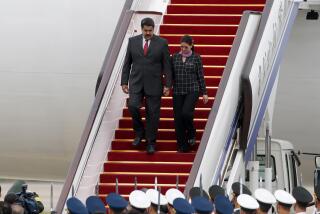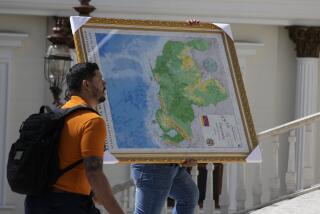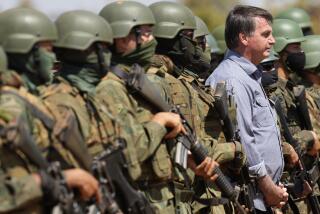Modest Brazil warplane fitting into nations’ plans
Reporting from Quito, Ecuador — Unsleek and unsupersonic, the Super Tucano hardly fits most people’s concept of a modern warplane. But Brazilian manufacturer Embraer is finding a growing market for the retro “light attack” propeller-driven aircraft among nations looking to secure their borders, fight drugs and support counterinsurgency operations.
FOR THE RECORD:
Brazil warplanes: An article in Tuesday’s Section A about the Brazilian warplane called the Super Tucano said a new military transport aircraft being developed by Brazilian manufacturer Embraer would compete with the Boeing C-130 Hercules. That aircraft is in fact manufactured by Lockheed Martin. —
Ecuador is one such customer. The two Super Tucanos that flew into Manta air base late last month were the first delivered on a 24-plane order that President Rafael Correa placed shortly after Colombian armed forces entered Ecuador’s airspace in March 2008 to kill a high-ranking FARC rebel leader, Raul Reyes.
Although the $250-million purchase was seen as a reaction to Colombia’s violation of its sovereignty, Correa in his weekly television address Feb. 6 said that the aircraft acquisition didn’t signal an arms buildup. Rather, he said, the planes were replacing Ecuador’s fleet of mostly 30-year-old A-37 Dragonfly aircraft made by Cessna.
But Correa is wrestling with a problem that the planes can help him confront: the persistent presence in his territory of guerrillas with the Revolutionary Armed Forces of Colombia or, FARC. Without specifically mentioning FARC, Correa said the aircraft would help support the Ecuadorean military as it fights “regular and irregular forces” inside the country’s borders.
(It was a Colombian air force Super Tucano that dropped the “smart bomb” that killed Reyes, then second in command of the FARC, as he slept at a camp a mile inside Ecuadorean territory.)
Relations between Colombia and Ecuador have improved since the 2008 incursion, when Correa briefly mobilized troops and froze trans-border commerce. Recently, the neighbors have reestablished diplomatic ties and resumed cooperation concerning drug interdiction and the FARC.
Colombian President Alvaro Uribe in 2008 justified the air operation, saying that Ecuador looked the other way when it came to the presence of the FARC. More recently, he thanked Correa after Ecuadorean armed forces killed three suspected FARC rebels in Ecuadorean territory Jan. 18.
The two-seater Super Tucano’s top speed is only about 350 mph. But it has a 620-mile combat radius and can stay aloft for six hours. Introduced in 2003, the plane can be outfitted with two heavy machine guns as well as 2 tons of guided bombs and rockets, said Robert Munks, an Americas analyst for IHS Jane’s military consultants in London.
With their uses in training, surveillance and offensive campaigns, the Super Tucanos fit the bill for many Third World countries, and at $10 million each, are relatively cheap, Munks said.
After five years in service with the Colombian air force, the planes have proved their worth in anti-drug and counterinsurgency operations, he said.
Chile and the Dominican Republic have bought Super Tucanos. An Embraer spokesman declined to comment on reports that Indonesia and Peru have also placed orders.
The Pentagon is considering buying 200 of the aircraft, and Britain’s Royal Air Force is weighing the possibility of replacing its fleet of Harrier vertical takeoff jets with Super Tucanos instead of Lockheed Martin F-35Bs, which cost 10 times as much.
If the Pentagon buys the planes -- 100 each for the Navy and Air Force, according to reports -- the order would equal the total number of Super Tucanos that have been sold to date.
The principal customers have been the air forces of Brazil, with 99, and Colombia, which bought 25.
Promoting Super Tucano sales is part of Brazil’s ambitious campaign to raise its profile as a military power, as well as a manufacturer. In its strategic defense plan unveiled in 2008, Brazil said it was doing so to diversify its economy while protecting its natural resources.
In joint deals with France, Brazil has embarked on technology-sharing projects to build its own fleet of helicopters and submarines.
The nation is also in the process of deciding between French, Swedish and U.S. jet aircraft manufacturers for a new multibillion-dollar fleet of fighter jets.
Embraer probably would have a role in building the aircraft. Embraer is also developing a new military transport plane called the KC-390 that will compete with Boeing’s C-130 Hercules. France has promised to buy several of them.
Kraul is a special correspondent.
More to Read
Sign up for Essential California
The most important California stories and recommendations in your inbox every morning.
You may occasionally receive promotional content from the Los Angeles Times.










